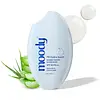What's inside
What's inside
 Key Ingredients
Key Ingredients

 Benefits
Benefits

 Concerns
Concerns

 Ingredients Side-by-side
Ingredients Side-by-side

Water
Skin ConditioningEthylhexyl Methoxycinnamate
UV AbsorberOctocrylene
UV AbsorberButyl Methoxydibenzoylmethane
UV AbsorberGlycerin
HumectantPropanediol
SolventDicaprylyl Carbonate
EmollientCocos Nucifera Fruit Extract
EmollientHydrolyzed Hyaluronic Acid
HumectantAloe Barbadensis Leaf Juice
Skin ConditioningPanthenol
Skin ConditioningTocopheryl Acetate
AntioxidantXanthan Gum
EmulsifyingSorbitol
HumectantTitanium Dioxide
Cosmetic ColorantPolyacrylate-13
Polyisobutene
Cetearyl Alcohol
EmollientAlcohol
AntimicrobialC9-11 Alkyl Glucoside
CleansingHydrogenated Castor Oil
EmollientSodium Gluconate
Skin ConditioningEthylhexylglycerin
Skin ConditioningPhenoxyethanol
PreservativeWater, Ethylhexyl Methoxycinnamate, Octocrylene, Butyl Methoxydibenzoylmethane, Glycerin, Propanediol, Dicaprylyl Carbonate, Cocos Nucifera Fruit Extract, Hydrolyzed Hyaluronic Acid, Aloe Barbadensis Leaf Juice, Panthenol, Tocopheryl Acetate, Xanthan Gum, Sorbitol, Titanium Dioxide, Polyacrylate-13, Polyisobutene, Cetearyl Alcohol, Alcohol, C9-11 Alkyl Glucoside, Hydrogenated Castor Oil, Sodium Gluconate, Ethylhexylglycerin, Phenoxyethanol
Copernicia Cerifera Wax
Euphorbia Cerifera Wax
Cocos Nucifera Oil
MaskingButyrospermum Parkii Butter
Skin ConditioningRicinus Communis Seed Oil
MaskingOlea Europaea Fruit Oil
MaskingGlycine Soja Lipids
Skin ConditioningGlycerin
HumectantEuterpe Oleracea Fruit Oil
Skin ConditioningKojic Dipalmitate
EmollientHydrolyzed Hyaluronic Acid
HumectantCeramide AP
Skin ConditioningLauryl Laurate
Skin ConditioningTocopheryl Acetate
AntioxidantEthylhexylglycerin
Skin ConditioningPhenoxyethanol
PreservativeCopernicia Cerifera Wax, Euphorbia Cerifera Wax, Cocos Nucifera Oil, Butyrospermum Parkii Butter, Ricinus Communis Seed Oil, Olea Europaea Fruit Oil, Glycine Soja Lipids, Glycerin, Euterpe Oleracea Fruit Oil, Kojic Dipalmitate, Hydrolyzed Hyaluronic Acid, Ceramide AP, Lauryl Laurate, Tocopheryl Acetate, Ethylhexylglycerin, Phenoxyethanol
Ingredients Explained
These ingredients are found in both products.
Ingredients higher up in an ingredient list are typically present in a larger amount.
Ethylhexylglycerin (we can't pronounce this either) is commonly used as a preservative and skin softener. It is derived from glyceryl.
You might see Ethylhexylglycerin often paired with other preservatives such as phenoxyethanol. Ethylhexylglycerin has been found to increase the effectiveness of these other preservatives.
Glycerin is already naturally found in your skin. It helps moisturize and protect your skin.
A study from 2016 found glycerin to be more effective as a humectant than AHAs and hyaluronic acid.
As a humectant, it helps the skin stay hydrated by pulling moisture to your skin. The low molecular weight of glycerin allows it to pull moisture into the deeper layers of your skin.
Hydrated skin improves your skin barrier; Your skin barrier helps protect against irritants and bacteria.
Glycerin has also been found to have antimicrobial and antiviral properties. Due to these properties, glycerin is often used in wound and burn treatments.
In cosmetics, glycerin is usually derived from plants such as soybean or palm. However, it can also be sourced from animals, such as tallow or animal fat.
This ingredient is organic, colorless, odorless, and non-toxic.
Glycerin is the name for this ingredient in American English. British English uses Glycerol/Glycerine.
Learn more about GlycerinHydrolyzed Hyaluronic Acid is a form of hyaluronic acid. It is created by the hydrolysis of hyaluronic acid with a high molecular weight. Once created, Hydrolyzed Hyaluronic Acid has a low molecular weight.
Low molecular weight HA has been shown to hydrate and increase elasticity of the skin. Increasing elasticity is also associated with reduction of wrinkle depth.
One study found topical low molecular weight hyaluronic acid may be considered for the treatment of rosacea in the adult population. However, we always recommend speaking with a professional about your skin concerns.
Hyaluronic acids are a humectant. This means they draw moisture from the air. Hyaluronic acids help moisturize, soothe, and protect the skin.
Read more about other common forms of hyaluronic acid:
Learn more about Hydrolyzed Hyaluronic AcidPhenoxyethanol is a preservative that has germicide, antimicrobial, and aromatic properties. Studies show that phenoxyethanol can prevent microbial growth. By itself, it has a scent that is similar to that of a rose.
It's often used in formulations along with Caprylyl Glycol to preserve the shelf life of products.
Tocopheryl Acetate is AKA Vitamin E. It is an antioxidant and protects your skin from free radicals. Free radicals damage the skin by breaking down collagen.
One study found using Tocopheryl Acetate with Vitamin C decreased the number of sunburned cells.
Tocopheryl Acetate is commonly found in both skincare and dietary supplements.
Learn more about Tocopheryl Acetate